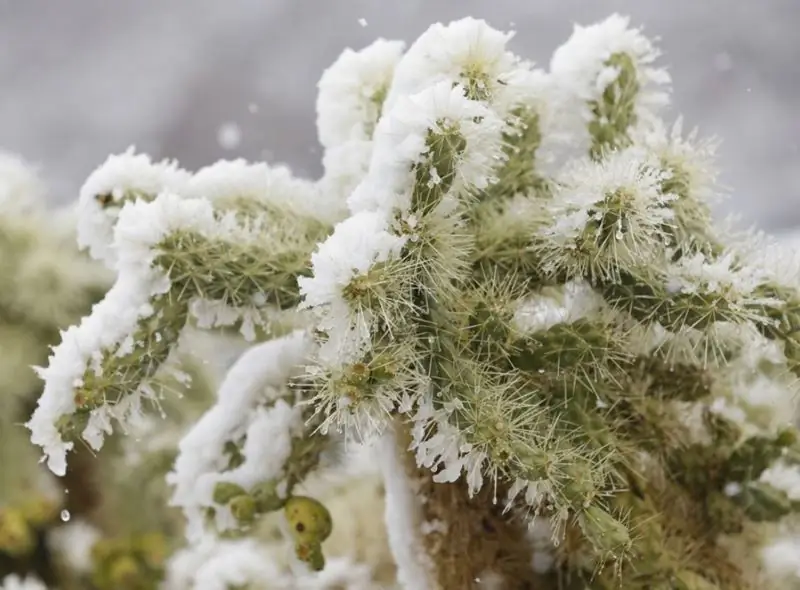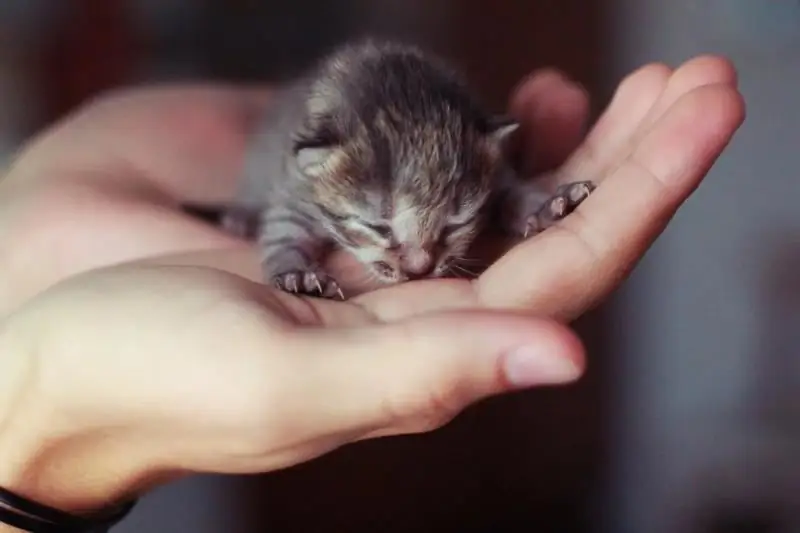
Table of contents:
- Author Bailey Albertson [email protected].
- Public 2023-12-17 12:53.
- Last modified 2025-01-23 12:41.
Do your cacti winter properly?

Winter for cacti is a cool and dry rest. If these conditions are met, then there is a chance that in the spring your thorny pets will delight you with their flowering.
How to care for cacti in winter
Sometimes it seems that everything is easy with cacti. But if you set yourself the goal of seeing the spring-summer flowering of your favorites, then you will have to fulfill a lot of conditions. Let's consider them in more detail.
Cubby
For cacti, this will be a light and cool window sill, where heat from the heating battery does not reach. Therefore, it is good if the stands on which the pots are standing are high enough and the window sills wide enough to place the pots closer to the glass.

In such a "aquarium without water" cacti can be ideal for wintering
To create comfortable conditions for cacti, some cactus growers arrange winter "greenhouses" for their thorny favorites, which outwardly resemble an aquarium without water.
Comfort temperature
The temperature should be taken under special control, and therefore there should always be a thermometer on the windowsill.

A thermometer on the windowsill next to the cacti will help keep your pets comfortable microclimate
After all, the optimal temperature for cacti in winter is also not easy. A suitable winter temperature for them ranges from + 12 to +5 o C. To maintain it, many growers install a plexiglass sheet on the window sill from the side of the room in order to block the flow of warm air from the radiator.

Cacti need to be protected from both excessive heat and outdoor frost.
Is winter food required
In winter, cacti do not need food. You can start feeding at the beginning of spring, in March.
And if you need to transplant

If the cactus pot is too small, you can transplant it into a larger pot by mid-December
You can transplant a cactus in winter, if the need arises. Suddenly it turned out that the pot was too small for him, and his hands had not reached him earlier. But it would be better to have time to do this before mid-December. Or already postponed until spring.
Do i need water
With the beginning of winter (from mid-November to March), the watering of desert cacti is sharply reduced: they are watered in the literal sense with drops once every 3-4 weeks. You can moisten the soil a little more if you find that your cactus is very shriveled. Watering should be along the edge of the pot, avoiding water getting on the root collar. This is due to the fact that moist soil at low temperatures can provoke root rot.

If the cacti are not shriveled, watering them in winter is required from a pipette and very rarely
Table: differences between cacti in relation to the frequency of watering in winter
| Cacti that don't need watering in winter | Cacti that need light soil moisture |
|
Opuntia Opuntia (temperature from +5 to +10) Opuntia artikulata Opuntia articulata (Tephrocactus articulatus Tefrokaktusa artikulyatus) (quiescent period in extreme cold 0 degrees and without any watering!) Mammillaria Mammillaria, Dolihotele Dolichothele Parodii Parodia Lobiv Lobivia, Psevdolobivii Pseudolobivia, Mediolobivii Mediolobivia Rebutia Rebutia, Sulcorebutia Sulcorebutia Ailostera Aylostera Echinopsis Echinopsis Copiapoa Copiapoa Astrophytums Astrophytum Ferocactus Ferocactus Coryphants Coryphantha Matucana Matucana, Submatucana Submatucana Chileans, Echinopsis Neochiocilentia) Cephalocerius Cephalocereus (absolutely dry and cool (+15) wintering) Turbinicarpus Turbinicarpus (do not water, cold wintering) Echinocactus Echinocactus (about +8 - +10, if higher, about +15, you can pour a little into the pallet once a month) Aztekium Aztekium Lophophora Lophophora |
Brazilopuntsiya Brasiliopuntia cylindropuntia Cylindropuntia acanthocalycium Acanthocalycium Koleotsefalotsereus Coleocephalocereus discocactus Discocactus Harris Harrisia Notocactus Notocactus cleistocactus Cleistocactus Gymnocalycium Gymnocalycium Ehinofossulokaktus Echinofossulocactu thelocactus Thelocactus Mirtilokaktus Myrtillocactus hatiora Hatiora hylocereus Hylocereus Lepismium Lepismium Pilozotsereus Pilosocereus Kvabentiya Quiabentia Rhipsalis Ripsalis Schlumberger Schlumbergera Veberotsereus Weberocereus |

Schlumberger and other forest cacti are watered more than desert cacti
Air humidity
Cacti love humid air and spraying, but these procedures are carried out only in summer and only in a warm room. In winter, during the dormant period, cacti need to ensure dry air and no spraying.

You should not arrange any spraying of cacti in winter
Lighting

When dormant, cacti do not need bright light.
Already from the beginning of October, cacti may need additional lighting with halogen lamps so that the period of daylight hours is at least 14 hours. Ideally, the additional illumination will be created using cold light bulbs that do not create a problem of temperature rise.
An important point is the withdrawal of cacti from dormancy. When the temperature outside the window found above 15 on C, to start spraying every morning over small cacti moisture spray. They will take this as a signal that spring has come, dew has appeared. And they will start to wake up.

The start of spraying is a signal that it's time to wake up
Video: caring for cacti in winter

After a properly organized wintering, cacti will delight you with their abundant flowering
If you manage to create ideal wintering conditions for your cacti, they will lay and form buds and will certainly delight you with their varied flowering.
Recommended:
How To Transplant Spathiphyllum (female Happiness) At Home

Rules for transplanting spathiphyllum and subsequent care for it. Preparation, step-by-step description of the process. What problems can arise and how to deal with them?
How To Transplant An Orchid At Home Correctly + Video And Photo

Orchid transplant rules. Necessary materials, planting methods, step-by-step instructions for planting a plant in a new pot
Is It Possible To Feed A Cat Only Dry Food: Basic Rules Of Feeding, How To Give The Product Correctly, Advice From Veterinarians

What can be dangerous dry food. How to keep your pet safe when eating ready-made rations. Basic rules for feeding granulated foods
How To Feed A Kitten At 1 Month Without A Cat: How To Feed Newborn Cats At Home, Recommendations Of Veterinarians

How to feed and care for a kitten without a cat. What is needed for feeding. Mix selection. Transfer to self-catering. Kitten weight gain
Why Cats Are Afraid Of Water: Reasons For Fear, Rules For Bathing At Home, Is It Possible To Teach A Cat To Water Procedures, Video

Are cats afraid of water; swimming cat breeds; why the cat does not like to get wet; how to teach her to wash; what to do if this is not possible. Owner tips
